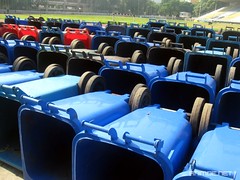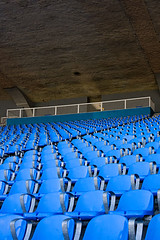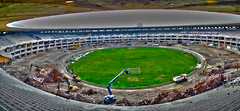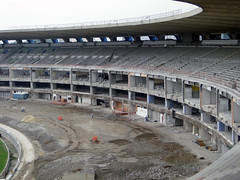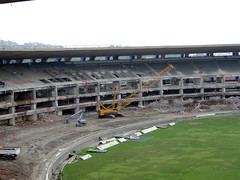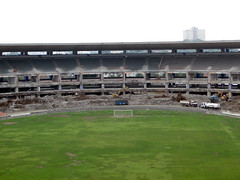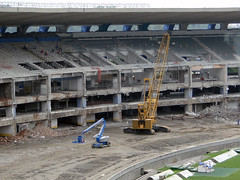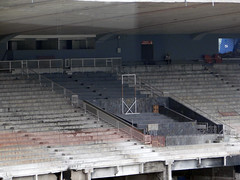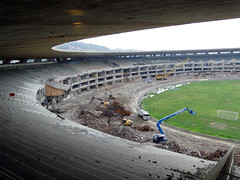Estádio do Maracanã
Maracanã Stadium (Portuguese: Estádio do Maracanã, Portuguese: [esˈtadʒi.u du maɾakɐˈnɐ̃]), officially named Estádio Jornalista Mário Filho (Portuguese: [isˈtadʒ(i)u ʒoʁnaˈlistɐ ˈmaɾi.u ˈfiʎu]), is an association football stadium in Rio de Janeiro, Brazil. The stadium is part of a complex that includes an arena known by the name of ''Maracanãzinho'', which means "The Little Maracanã" in Portuguese. Owned by the Rio de Janeiro state government, the stadium is now managed by the clubs Flamengo and Fluminense. It is located at the Maracanã neighborhood, named after the Rio Maracanã, a now canalized river in Rio de Janeiro.
The stadium was opened in 1950 to host the FIFA World Cup, in which Brazil was beaten 2–1 by Uruguay in the deciding game, in front of a still standing record attendance of 173,850 spectators, on 16 July 1950. The venue has seen attendances of 150,000 or more at 26 occasions, the last being on 29 May 1983, as 155,253 spectators watched Flamengo beat Santos, 3–0. The stadium has seen crowds of more than 100,000 284 times. But as terraced sections have been replaced with seats over time, and after the renovation for the 2014 FIFA World Cup, its original capacity has been reduced to the current 78,838, but it remains the largest stadium in Brazil and the third largest in South America after Estadio Monumental in Peru.
The stadium is mainly used for football matches between the major football clubs in Rio de Janeiro, including Flamengo, Fluminense, Botafogo, and Vasco da Gama. It has also hosted a number of concerts and other sporting events. It was the main venue of the 2007 Pan American Games, hosting the football tournament and the opening and closing ceremonies. The Maracanã was partially rebuilt in preparation for the 2013 FIFA Confederations Cup, and the 2014 World Cup, for which it hosted several matches, including the final. It also served as the venue for the opening and closing ceremonies of the 2016 Summer Olympics and Paralympics, with the main track and field events taking place at the Estádio Olímpico. The stadium was also chosen to host the 2020 and 2023 Copa Libertadores finals.
Name
The stadium was named in 1966 in honor of the recently deceased Mário Filho, a Pernambucan sports journalist, the brother of Nelson Rodrigues, who was a strong vocal supporter of the construction of the Maracanã.
The stadium's popular name is derived from the Maracanã River, whose point of origin is in the jungle-covered hills to the west, crossing various bairros (neighborhoods) of Rio's Zona Norte (North Zone), such as Tijuca and São Cristóvão, via a drainage canal which features sloping sides constructed of concrete. Upon flowing into the Canal do Mangue, it empties into Guanabara Bay. The name "Maracanã" derives from the indigenous Tupi–Guarani word for a type of parrot which inhabited the region. The stadium construction was prior to the formation of the later Maracanã neighborhood, that was once part of Tijuca.
The stadium of Red Star Belgrade, the Red Star Stadium, is popularly called Marakana in honor of the Brazilian stadium.
In March 2021, the Rio de Janeiro state legislature voted to change the venue's name to the Edson Arantes do Nascimento - Rei Pele stadium. Edson Arantes do Nascimento was the 82-year-old's full name, while Rei means king in Portuguese. The Rio de Janeiro's state governor must approve the name change before it becomes official.
History
Construction
After winning the right to host the 1950 FIFA World Cup, the Brazilian government sought to build a new stadium for the tournament. The construction of Maracanã was criticized by Carlos Lacerda, then Congressman and political enemy of the mayor of the city, general Ângelo Mendes de Morais, for the expense and for the chosen location of the stadium, arguing that it should be built in the West Zone neighborhood of Jacarepaguá. At the time, a tennis stadium stood in the chosen area. Still it was supported by journalist Mário Filho, and Mendes de Morais was able to move the project forward. The competition for the design and construction was opened by the municipality of Rio de Janeiro in 1947, with the construction contract awarded to engineer Humberto Menescal, and the architectural contract awarded to seven Brazilian architects, Michael Feldman, Waldir Ramos, Raphael Galvão, Oscar Valdetaro, Orlando Azevedo, Pedro Paulo Bernardes Bastos, and Antônio Dias Carneiro.
The first cornerstone was laid at the site of the stadium on 2 August 1948. With the first World Cup game scheduled to be played on 24 June 1950, this left a little under two years to finish construction. However, work quickly fell behind schedule, prompting FIFA to send Ottorino Barassi, the head of the Italian FA, who had organized the 1934 World Cup, to help in Rio de Janeiro. A work force of 1,500 constructed the stadium, with an additional 2,000 working in the final months. Despite the stadium having come into use in 1950, the construction was only fully completed in 1965.
Opening and 1950 FIFA World Cup
The opening match of the stadium took place on 16 June 1950. Rio de Janeiro All-Stars beat São Paulo All-Stars 3–1; Didi became the player to score the first ever goal at the stadium. While the major part of the stadium was finished, it still looked like a construction site; it lacked toilet facilities and a press box. Brazilian officials claimed it could seat over 200,000 people, while the Guinness Book of World Records estimated it could seat 180,000 and other sources pegged capacity at 155,000. What is beyond dispute is that Maracanã overtook Hampden Park as the largest stadium in the world. Despite the stadium's unfinished state, FIFA allowed matches to be played at the venue, and on 24 June 1950, the first World Cup match took place, with 81,000 spectators in attendance.
In that first match for which Maracanã had been built, Brazil beat Mexico with a final score 4–0, with Ademir becoming the first scorer of a competitive goal at the stadium with his 30th-minute strike. Ademir had two goals in total, plus one each from Baltasar and Jair. The match was refereed by Englishman George Reader. Five of Brazil's six games at the tournament were played at Maracanã (the exception being their 2–2 draw with Switzerland in São Paulo). Eventually, Brazil progressed to the final round, facing Uruguay in the match (part of a round-robin final phase) that turned out to be the tournament-deciding match on 16 July 1950. Brazil only needed a draw to finish as champion, but Uruguay won the game 2–1, shocking and silencing the massive crowd. This defeat on home soil instantly became a significant event in Brazilian history, being known popularly as the Maracanazo. The official attendance of the final game was 199,854, with the actual attendance estimated to be about 210,000. In any case, it was the largest crowd ever to see a football game—a record that is highly unlikely to be threatened in an era when most international matches are played in all-seater stadiums. At the time of the World Cup, the stadium was mostly grandstands with no individual seats.
Stadium completion and post-World Cup years
Since the World Cup in 1950, Maracanã Stadium has mainly been used for club games involving four major football clubs in Rio — Vasco, Botafogo, Flamengo and Fluminense. The stadium has also hosted numerous domestic football cup finals, most notably the Copa do Brasil and the Campeonato Carioca. On 21 March 1954, a new official attendance record was set in the game between Brazil and Paraguay, after 183,513 spectators entered the stadium with a ticket and 194,603 (177,656 p) in Fla-Flu (1963). In 1963, stadium authorities replaced the square goal posts with round ones, but it was still two years before the stadium would be fully completed. In 1965, 17 years after construction began, the stadium was finally finished. In September 1966, upon the death of Mário Rodrigues Filho, the Brazilian journalist, columnist, sports figure, and prominent campaigner who was largely responsible for the stadium originally being built, the administrators of the stadium renamed the stadium after him: Estádio Jornalista Mário Rodrigues Filho. However, the nickname of Maracanã has continued to be used as the common referent. In 1969, Pelé scored the 1,000th goal of his career at Maracanã, against CR Vasco da Gama in front of 65,157 spectators.
In 1989, the stadium hosted the games of the final round of the Copa America; in the same year, Zico scored his final goal for Flamengo at the Maracanã, taking his goal tally at the stadium to 333, a record that still stood as of 2021. An upper stand in the stadium collapsed on 19 July 1992, in the second game of the finals of 1992 Campeonato Brasileiro Série A, between Botafogo and Flamengo, leading to the death of three spectators and injuring 50 others. Following the disaster, the stadium's capacity was greatly reduced as it was converted to an all-seater stadium in the late 1990s. Meanwhile, the ground was classified as a national landmark in 1998, meaning that it could not be demolished. The stadium hosted the first ever FIFA Club World Cup final match between CR Vasco da Gama and Corinthians Paulista, which Corinthians won on penalties.
21st century, renovations and 2014 FIFA World Cup
Following its 50th anniversary in 2000, the stadium underwent renovations which would increase its full capacity to around 103,000. After years of planning and nine months of closure between 2005 and 2006, the stadium was reopened in January 2007 with an all-seated capacity of 87,000.
For the 2014 World Cup and 2016 Olympics and Paralympics, a major reconstruction project was initiated in 2010. The original seating bowl, with a two-tier configuration, was demolished, giving way to a new one-tier seating bowl. The original stadium's roof in concrete was removed and replaced with a fiberglass tensioned membrane coated with polytetra-fluoroethylene. The new roof covers 95% of the seats inside the st…
Looking for places related to Estádio do Maracanã?
Those are other destinations to find places related to Estádio do Maracanã:
- Sugarloaf Mountain
- Rio–Niterói Bridge
- Christ the Redeemer
- Santos Dumont Airpo…
- Corcovado
- Rio de Janeiro Bota…
- do Maracanã
- Tijuca Forest
- Teatro Municipal
- Olímpico João Havel…
- Paço Imperial
- São Januário
- Sambadrome Marquês …
- Museum of Modern Ar…
- das Laranjeiras
- Federal University …
- National Library of…
- Colégio Pedro II
- Colégio de São Bento
- Museu do Índio
- Ginásio do Maracanã…
- Cemitério dos Ingle…
- Centro Federal de E…
- Pontifical Catholic…


